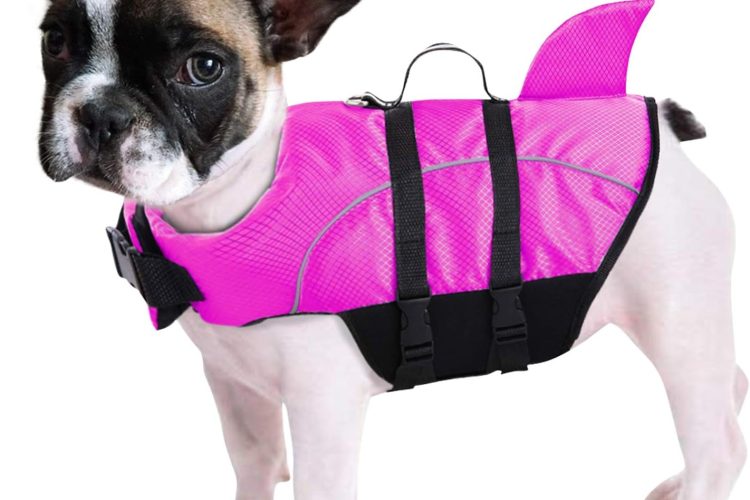
Is your dog pool safe? Are pool chemicals safe for dogs, what kind of dog pools are best, can my dog share our pool? These questions, and more, are answered in this special edition article about pets and swimming pools.
If you are designing a new pool with your pet in mind, or already have a pool and a pet, you will find this post a valuable resource. It is loaded with tips and advice for you and your furry friend to have fun, stay safe, and maintain healthy crystal clear water.
For those looking just to buy and maintain a small plastic pool for your dog, we have advice and information for you too.
Is Chlorine Bad for Dogs?
No! Chlorine is not bad for dogs. While you don’t want to encourage your pooch to drink pool water, chlorinated pool water is as safe for your canine as it is for you. I remember my grandmother shouting to us all the time – “Don’t drink my pool water”.
When it comes to dogs in and around swimming pools, you should think of your pet like a child, which most of us do anyway. Keep chemicals stored away safely, make a barrier (fence/gate) to the entry, so they cannot use the pool without you there (most cases). If your pet should get into any chemicals, seek medical attention right away!
Like some children, some puppies are allergic to chlorine, or it may irritate their skin. It is always a good idea to rinse off your pet once they are finished with the pool. Pay close attention the first few times your pet is exposed to chlorine to check for sensitivity.
What about Bromine?
Bromine is expensive and it does not last long when exposed to sunlight. It is a safe alternative for indoor pools, but is not well suited to outdoor swimming pools.
Bromine is just another form of chlorine, without the smell of chlorine. Not to mention you still need to shock the pool with chlorine occasionally. Regular chlorine is still the best and cheapest way to maintain healthy pool water.
Mineral Erosion Feeders & UV light
If you want to maintain lower levels of chlorine, and still maintain healthy sanitary pool water for you and your pet, both UV light and mineral feeders are great supplemental systems. Many states have now mandated the use of UV light in public swimming pools.
Other Pool Chemicals & your Pet
The only other chemical you need to maintain for you and your pets health is pH. It is said that pH and chlorine are for you, and the rest of the chemicals are for the pool and pool equipment.
Your water hardness (calcium), pH stabilizer (alkalinity), Chlorine stabilizer (CYA), are all for your pool shell and equipment health, and to keep chemical costs down.
Exposure to these diluted chemicals at proper levels pose no risk to you or your puppy. Here is another great resource from Pet MD.com
Pool Design with Pet in Mind
If you are remodeling, buying new equipment, or designing a new pool that your dog will swim in, this section is for you. Dogs are said to equal the bather load of three people. Also, as they do not have an opposable thumb, they can’t wipe as well after using the facilities. 😀
Plumbing and Filtration
When installing a new pool or replacing equipment with your dog in mind, bigger is better. Get a big filter with a lot of capacity. I always recommend a large filter, but if your dog will be in the pool, the bigger, the better. I would recommend sand or a DE filter, as cartridge filters can be tough to remove your pet’s hair.
Most state codes require that residential pools turn the water over once every 24 hours. This means that every gallon of pool water goes through the filter. To do this you will need good plumbing and a good pump.
Many pools are built with 1 inch or 1.5 inch diameter plumbing. With your dog in the pool, due to the fur issue, it is recommended to go with a minimum of two inch plumbing to prevent build up or clogging; 2.5 or 3 inch pipes are even better.
Nowadays most homeowners install energy efficient variable speed pool pumps to meet necessary demand. But many older pools still have a one speed pump. No matter what your system, when your pet is using the pool, you should increase the turnover rate to two times a day. If you have multiple pets that use the pool you can increase the rate.
Having large diameter plumbing, and a huge filter will save you time and aggravation with pool maintenance, and ensure you always have sparkling crystal clear healthy pool water.
Pool Types
There are three main types of pool, and your dog can go into any of them.
- Vinyl
- Fiberglass
- Cement
Vinyl Pools
All above ground swimming pools, and many inground pools have a vinyl liner. If your dog will be using a vinyl lined pool, you will have to take extra care. These pools which are usually the least expensive to install, end up costing the most when dogs use the pool.
If you have plastic steps, and can train your pet to stay away from the pool wall, it can work. But it is too easy to end up in a situation where you need to replace the pool liner due to tears, at a cost of 3k or more for inground pools, and 800 minimum for above ground pools.
Fiberglass Swimming pools
Fiberglass pools are considered the best for a few reasons. The finish is smooth (unlike concrete), so it wont hurt your pets pads or tear out nails. The finish is tough (unlike vinyl), and can withstand the sharp nails of your pet. Lastly, it is less expensive to buy, install, or maintain than cement or vinyl.
Cement Swimming Pools
Cement pools do not have the same disadvantages as vinyl, but the surface is hard, and often times rough. When the plaster of a cement pool gets scratched it becomes more open to algae growth. Cement pools are harder on the joints of aging dogs and people alike. There is also the added disadvantage of needing to be resurfaced every 7-9 years.
Small Kiddie Pools For Dogs
Having read the above information, you can see how much filtration is needed to maintain healthy pool water. And our large pools have a lot more water, plus the added benefit of chlorine to sanitize it. This is why we recommend you change the water in small dog pools every day.
Left unchanged, your dogs pool water can quickly become smelly and even unhealthy. Who knows what animals are using the water over night.
Like I said at the beginning, treat your pet like a small child. You wouldn’t let a child play in bacteria infested mosquito pond, and neither should your doggy.
Stay away from blow up pools for your pet. They will pop it in no time at all. If they do not gnaw on the side, their nails will destroy it real quick.
Here is a popular portable pool or tubby for dogs
Safety Features & Advice for your Dogs Pool
Swimming Lessons
Who hasn’t heard of the doggie paddle? Yet not all dogs are natural swimmers and should be slowly introduced to the pool. Smaller breeds with short legs, or even muscular pups can have trouble floating and swimming.
Dogs that have never been exposed to water should be started out on the steps or ramp with a leash. Let them get comfortable in the shallows. Like young children you need to keep an eye on them. For some, you may need to consider a swimming vest to help support them.
- K-9 life-jacket and vests can be had on amazon for between 9-20 bucks (LINK).
- Luxury Floats for you and your pet are also available, making pool time more fun.
Escape Routes
10,000 dogs and cats drown every year. If a pet falls in and panics, they can easily take on water and drown. You need to have a clear defined exit for your companion. Whether this is a ramp or a set of steps, it helps to have an identifiable marker on the deck that your pet can spot from in the water.
Depending on the length of your pets legs, it may be easier for them to exit the pool by way of a ramp rather than a set of steps.

Going back to design, if you’re building a new pool, a ramp is a great added feature for your pet. If you have an existing pool, there are aftermarket products like this ramp.
For pool owners that are sick of fishing dead chipmunks, squirrels, rabbits, etc out from your pool skimmer, this ramp provides a way out for all animals.
It works well for large and small pets.
Fresh Water for your Pet
If you keep your K9 companion well hydrated with fresh water, it will drink less chlorinated water. As we already said, it is best to discourage drinking the pool water. To this end it is a good idea that you keep fresh water pool side for your pet.
Scratches
If you or children intend to use the pool with your pet, try to keep larger breeds and even smaller animals at arms length, and keep an eye out for small children.
Not only can your pool liner develop leaks, but so can you and your children. Scratches happen, but with proper planning and education, most accidents can be avoided.
Sanitation
Believe it or not, it is recommended that all people shower off before entering the pool. Humans carry sweat (ammonia), suntan lotion, oils, and even dirt into the pool. And while you puppy does not sweat, it also does not shower everyday like you do, not to mention the opposable thumb thing again.
It is a good idea to rinse your 4 legged friend well before entering the pool. And also when they exit. A sprinkler can be a fun way to rinse before and after.
Conclusion:
Swimming is great exercise for both you and your pet. Even older dogs with problems walking will find comfort in pools that have the proper water height, or on platforms that give them support. Your pool is perfectly safe for you and your pet if you mind what I have mentioned above.

